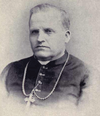.
Born in a rural area at the eastern extremity of Prince Edward Island, it is probable that Angus McDonald passed his first years in humble circumstances. Despite the irregular nature of his early
of Cape Breton the restive McDonald, then 44, moved to Prince Edward Island which was in a period of rapid growth and change owing to a heavy influx of immigrants, mostly from Scotland. On the Island
MacDonald* of Glenaladale, a Roman Catholic landed proprietor on St John’s (Prince Edward) Island, and Margaret MacDonald, Donald McDonald was educated by the Jesuits at Stonyhurst College in
raised to the priesthood. After his ordination he worked for three months in the parish of Saint-Roch before going back to Prince Edward Island.
On his
, Peter McIntyre papers; James Morrison papers. NA, RG 31, C1, 1881, 1891, Prince Edward Island. PARO, Acc. 3271, RBMB for All Saints’ Roman Catholic Church (Cardigan) and St James Roman Catholic
ordination, and he remained there until spring 1830. At that time Father McDonald departed for Prince Edward Island taking with him 206 Scots and Irish as tenants for the lands he had inherited. He settled the
.
Unlike fellow agent James Williams* on Prince Edward Island, McDonell did obey Selkirk’s summons to England to report in detail on his stewardship
.
Ian Ross Robertson
Prince Edward Island, Supreme Court, Estates Division
administered the sacraments to pastorless Church of Scotland people. For almost ten years this lone “shepherd of the Kirk” journeyed through the rugged terrain of eastern Nova Scotia and Prince Edward Island
.
The youngest of eight children, Peter McIntyre was early marked for the church. His parents had come to St John’s (Prince Edward) Island in 1790 as part of a large emigration from Highland Scotland
Bernard MacEachern*, who as Plessis’s suffragan was responsible for Prince Edward Island, New Brunswick, Cape Breton Island, and the Îles
town. He worked briefly for the Prince Edward Island Railway and tried his hand at journalism before moving to Ottawa, where he became a third-class clerk in the Privy Council Office on 11 March
in land in North America. He acquired a lot on St John’s (Prince Edward) Island and in 1773 was among several petitioners for 250,000 acres in upper New York
.
McLeod was the son of a ship’s captain in Prince Edward Island, and his thoughts were never far from sailing and the “mid-Atlantic’s pure breezes.” Educated at local schools, he read law for three years
a Charlottetown firm, and upon admission to the bar in 1873 he formed a partnership with Edward Jarvis Hodgson, with whom he would practise for some time before joining the firm of McLeod, Morson, and
.
Following a public-school education in Scotland, Angus McMillan immigrated to Prince Edward Island with his parents and siblings in 1834. The family settled in Wheatley River and engaged in farming. Scant
that he receive a grant on St John’s (Prince Edward) Island. Moreover, in December 1763 he submitted a plan to introduce 200,000 settlers into Nova Scotia and elsewhere in North America without
who emigrated to eastern Nova Scotia in 1833 and moved to southeastern Prince Edward Island in 1844, William McPhail was a licensed teacher at Newtown (Newtown Cross) by 1847. He taught in a number of
, overlooking Bedford Basin near Halifax. This hostelry was much frequented during the time Prince Edward* Augustus was at Halifax and throughout the
Brunswick, Prince Edward Island, Newfoundland and Bermuda. . . . ([Sackville], n.d.). I. C. Knowlton, Annals of Calais, Maine, and St. Stephen, New Brunswick






